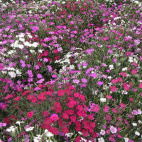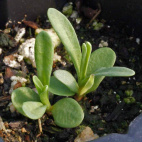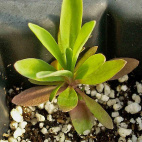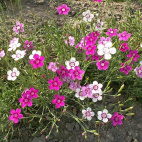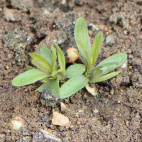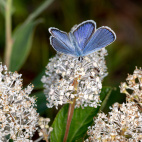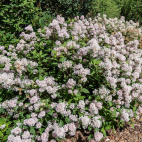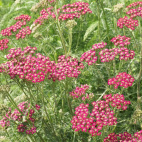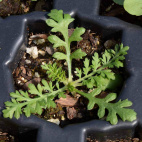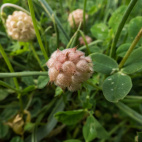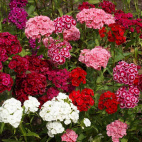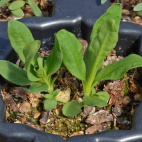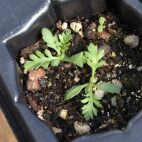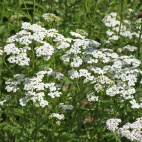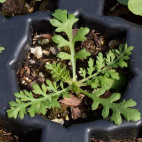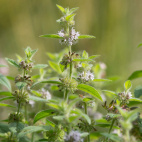Color
Availability
USDA Zone
Region
Type
Duration
Season
Germination
Soil
Sunlight
Height
Use
Narrow Your Search
Color
Availability
USDA Zone
Region
Type
Duration
Season
Germination
Soil
Sunlight
Height
Use
Wildflower Seeds - Northern Region
The Northern region is home to our Canadian friends in the eastern provinces, as well as the northern-most part of the Eastern US. This area is characterized by a long, cold winter with lots of snow, and a short humid summer that only lasts about 3 or 4 months. Most of the area is classified as a UDSA Growing Zone 4 or less, and the species that grow here have interesting ways to perpetuate themselves in spite of the short growing season. There are a lot of forests and wetlands in this region, so adequate moisture is hardly ever a problem. Look up your growing zone to make sure that the Northern wildflower seeds that you want to grow are winter hardy. Alternatively, just order annual flower seeds online so that the plant does not need to make it through the winter, but can reseed itself and come back from seed the next year.
-
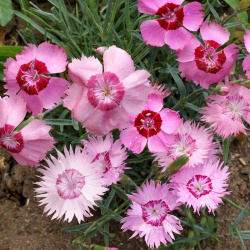 On Sale!
Cottage Pinks Seeds
Dianthus plumarius
Perfect for a cottage garden, these delicate blossoms bring sweet, old-fashioned charm. This perennial gives off a distinctive, clove-like scent, and is very easy to grow.Quick View$3.75 Pkt - $11.47 / Oz
On Sale!
Cottage Pinks Seeds
Dianthus plumarius
Perfect for a cottage garden, these delicate blossoms bring sweet, old-fashioned charm. This perennial gives off a distinctive, clove-like scent, and is very easy to grow.Quick View$3.75 Pkt - $11.47 / Oz -
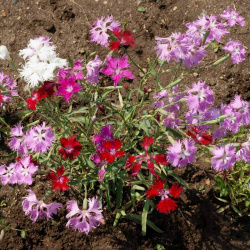 Fringed Pinks Seeds
Dianthus superbus
These lovely fringed pink flowers will fill the air with a heavenly scent. The exotic lacy blossoms range from pink to white and blooms in early spring of the second season. Very easy to grow, and very fancy to see.Quick View$2.98 Pkt - $12.65 / Oz
Fringed Pinks Seeds
Dianthus superbus
These lovely fringed pink flowers will fill the air with a heavenly scent. The exotic lacy blossoms range from pink to white and blooms in early spring of the second season. Very easy to grow, and very fancy to see.Quick View$2.98 Pkt - $12.65 / Oz -
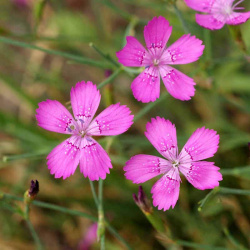 On Sale!
Maiden Pinks Seeds
Dianthus deltoides
Pretty as pink, these little beauties are a pleasure to cultivate. This easy-to-grow perennial makes a wonderful kind for a child or beginning gardener to try.Quick View$3.48 Pkt - $14.49 / Oz
On Sale!
Maiden Pinks Seeds
Dianthus deltoides
Pretty as pink, these little beauties are a pleasure to cultivate. This easy-to-grow perennial makes a wonderful kind for a child or beginning gardener to try.Quick View$3.48 Pkt - $14.49 / Oz -
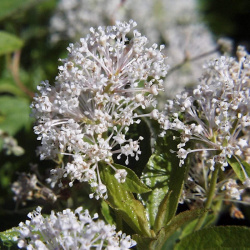 New Jersey Tea Seeds
Ceanothus americanus
Once used by American colonists as a tea substitute, this low-growing shrub bears fragrant white flower clusters. It also makes a lovely border or addition to prairie plantings.Quick View$3.75 Pkt - $80.00 / Oz
New Jersey Tea Seeds
Ceanothus americanus
Once used by American colonists as a tea substitute, this low-growing shrub bears fragrant white flower clusters. It also makes a lovely border or addition to prairie plantings.Quick View$3.75 Pkt - $80.00 / Oz -
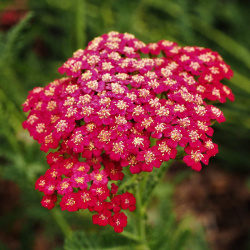 Red Yarrow Seeds
Achillea millefolium rubra
Fragrant foliage and cheerful, long-lasting flowers make this an enduring favorite. Try this variety if you want to add color to a dry area. Yarrow is also valued for its herbal properties.Quick View$3.48 Pkt - $18.77 / Oz
Red Yarrow Seeds
Achillea millefolium rubra
Fragrant foliage and cheerful, long-lasting flowers make this an enduring favorite. Try this variety if you want to add color to a dry area. Yarrow is also valued for its herbal properties.Quick View$3.48 Pkt - $18.77 / Oz -
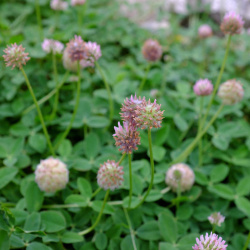 On Sale!
Strawberry Palestine Clover Seeds
Trifolium fragiferum
Since it tolerates flooding and coastal exposure, this hardy plant is valued for its versatility as a ground cover or grazing plant. This variety also withstands alkaline and saline conditions and is a good nectar source for honeybees.Quick View$3.48 Pkt - $6.84 / Oz
On Sale!
Strawberry Palestine Clover Seeds
Trifolium fragiferum
Since it tolerates flooding and coastal exposure, this hardy plant is valued for its versatility as a ground cover or grazing plant. This variety also withstands alkaline and saline conditions and is a good nectar source for honeybees.Quick View$3.48 Pkt - $6.84 / Oz -
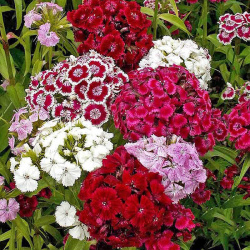 Sweet William Seeds
Dianthus barbatus
These sweetly-scented blossoms will bring irresistible charm to any flower bed. This delicate flower blooms in pink, red, and white, and is a happy camper in most garden conditions.Quick View$2.98 Pkt - $7.52 / Oz
Sweet William Seeds
Dianthus barbatus
These sweetly-scented blossoms will bring irresistible charm to any flower bed. This delicate flower blooms in pink, red, and white, and is a happy camper in most garden conditions.Quick View$2.98 Pkt - $7.52 / Oz -
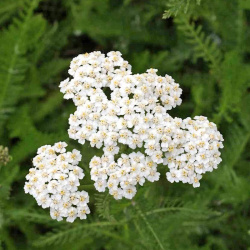 Western Yarrow Seeds
Achillea millefolium occidentalis
Growing clusters of small white flowers and feathery foliage, this is one of the most common wildflowers in the western United States. Yarrow makes an excellent pollen source in arid conditions.Quick View$2.98 Pkt - $9.54 / Oz
Western Yarrow Seeds
Achillea millefolium occidentalis
Growing clusters of small white flowers and feathery foliage, this is one of the most common wildflowers in the western United States. Yarrow makes an excellent pollen source in arid conditions.Quick View$2.98 Pkt - $9.54 / Oz -
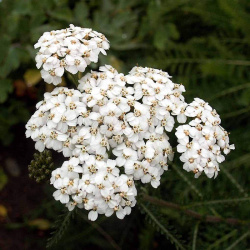 On Sale!
White Yarrow Seeds
Achillea millefolium
This wildflower is a common sight across the US and is often found growing in dry soils. The foliage is aromatic, and the long-lasting flowers work well for dried arrangements. Yarrow is also a valuable species for its herbal properties.Quick View$2.98 Pkt - $8.20 / Oz
On Sale!
White Yarrow Seeds
Achillea millefolium
This wildflower is a common sight across the US and is often found growing in dry soils. The foliage is aromatic, and the long-lasting flowers work well for dried arrangements. Yarrow is also a valuable species for its herbal properties.Quick View$2.98 Pkt - $8.20 / Oz -
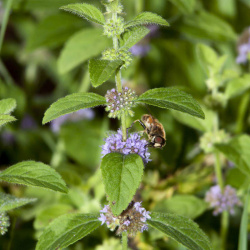 On Sale!
Wild Mint Seeds
Mentha arvensis
Containing a valuable essential oil, the leaves of this mint have numerous culinary and medicinal uses. This very minty perennial also bears small white to lavender flowers that always create a buzz among the honeybees.Quick View$3.75 Pkt - $120.00 / Oz
On Sale!
Wild Mint Seeds
Mentha arvensis
Containing a valuable essential oil, the leaves of this mint have numerous culinary and medicinal uses. This very minty perennial also bears small white to lavender flowers that always create a buzz among the honeybees.Quick View$3.75 Pkt - $120.00 / Oz
The Northern region is home to our Canadian friends in the eastern provinces, as well as the northern-most part of the Eastern US. This area is characterized by a long, cold winter with lots of snow, and a short humid summer that only lasts about 3 or 4 months. Most of the area is classified as a UDSA Growing Zone 4 or less, and the species that grow here have interesting ways to perpetuate themselves in spite of the short growing season. There are a lot of forests and wetlands in this region, so adequate moisture is hardly ever a problem. Look up your growing zone to make sure that the Northern wildflower seeds that you want to grow are winter hardy. Alternatively, just order annual flower seeds online so that the plant does not need to make it through the winter, but can reseed itself and come back from seed the next year.





